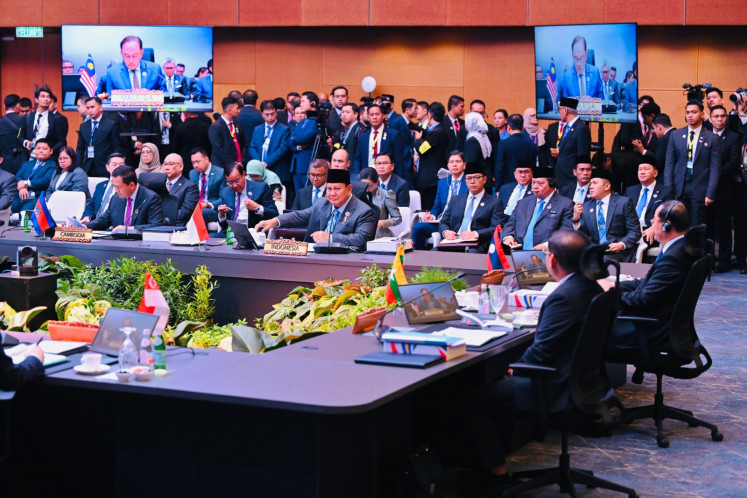Popular Reads
Top Results
Can't find what you're looking for?
View all search resultsPopular Reads
Top Results
Can't find what you're looking for?
View all search resultsHearing beyond limitations
Family affair: 18-year-old Gwendolyn Muljono (center) poses for a photograph with her mother San C
Change text size
Gift Premium Articles
to Anyone
F
amily affair: 18-year-old Gwendolyn Muljono (center) poses for a photograph with her mother San C. Wirakusuma (left) and father Johnwei Muljono (right) in their apartment.
‘Miracles do exist,’ say the parents of Gwendolyn Muljono, who have eventually been able to help their daughter, born with congenital hearing loss, acquire language skills successfully after years of hard work.
Words & Photos Sebastian Partogi
When you listen to the first 40 seconds of Gwendolyn ‘Gwen’ Muljono’s TEDx presentation called The Gift of Imperfection, you would be impressed by the 18-year-old student’s articulate explanation of a painting she created called Best of Both Worlds.
The painting features the same female figure torn in two: between the colorful smiling face on the right hand side of the picture and the somber face, washed in black and white, on the left hand side of the picture. Then, she hypothesizes on the audience members’ possible impression of the painting.
“[You might guess that the painting depicts] confusion, light versus dark, happiness versus sadness, or positivity versus negativity… well, this is actually a self-portrait,” she carried on with her impeccable presentation, before launching into her life story, the reason behind her TEDx talk title.
“I was born imperfect, I was born with hearing loss,” she said, before telling the audience how she had been greatly helped by cochlear implant devices to become the articulate young woman she is today.
Gwen’s story of her struggle of learning to acquire language and articulate it clearly despite the condition she had when she was born is in itself impressive, a story of how humans can actually go beyond their limitations, with the help of innovations in medical technology.
According to Gwen’s mother San C. Wirakusuma, her daughter was diagnosed with severe hearing loss in 2000 when she was as young as six months old, because San had been infected by cytomegalovirus (CMV) when she was in the third trimester of her pregnancy.
.According to the University of California San Diego Medical Journal, CMV is a virus that infects more than half of all adults by the age of 40, and stays for life. While most infected people are not aware that they have CMV because it rarely causes symptoms, the virus can cause serious health problems for people with compromised immune systems or babies infected with the virus before birth, the journal says.
The journal goes on to explain that currently, there are no treatments or vaccines for CMV. Gwen was born with congenital hearing problems.
According Dr. Eko Teguh Priyanto, an ear, nose and throat specialist at Siloam Hospitals Lippo Village, many congenital hearing problems can be detected shortly after a baby is born through an otoacoustic emission test, which looks at whether the cochlea — the organ inside the ear that translates sound vibrations into impulses the brain can understand — is functioning properly.
The simple test, which can be done even when the baby is sleeping, will record otoacoustic emissions that the cochlea produces when it processes sound.
“Congenital hearing defects have to be detected as early as possible [and as soon as you notice symptoms such as a child’s unresponsiveness to sound], and have to be treated right away,” Eko said.
“We advise that children aged three to four months are treated immediately if they are found to have hearing problems or inborn deafness.”
This is because the golden period for the formation of nerve cells in the brain’s auditory section takes place before a child turns two years old.
“If during this golden period children do not get auditory stimulation, the formation of brain synapses in the auditory area will be disrupted, causing lifelong impairment in the brain’s ability to process auditory stimulus,” he explained.
This is why parents should not underestimate hearing problems they observe among their children, assuming these will go away without any treatment.
Luckily, Gwen had a cochlear implant installed in her right ear when she was 18 months old and another implant installed in her left ear when she was 12. Prior to that, at 11 months she started auditory verbal therapy (AVT) to decipher and acquire language with the help of an external hearing aid, but her parents took her to Hong Kong for a cochlear implant as soon as they discovered that the external hearing aid did not work effectively.
There are generally two types of hearing aid and cochlear devices — analogue and digital — but in this day and age, the latter is preferred because it has better sound filters.
“Analogue hearing aid devices typically do not have very good filters, causing sounds from different frequencies to enter the ear at the same wavelength, which is very uncomfortable,” Eko said.
“Digital devices, meanwhile, have filters capable of blocking out sound frequencies that are not important based on their wavelengths.”
Visual oeuvre: Gwen’s sculpture responds to gun violence in the United States. Gwen was born with a congenital hearing impairment but is gifted with sharp visual acuity.Therapy
More technologically advanced hearing aid devices are also available, including ones equipped with artificial intelligence that can analyze sound sources to block out unnecessary noise. The RISE wireless technology produces clear sounds even in crowded or noisy places, while Inium wireless technology is able to process sound rapidly, resulting in high voice clarity.
A child with hearing problems needs auditory verbal therapy to help stimulate their brain’s auditory region, so that it can form the synapses necessary for the child to be able to process and comprehend auditory stimulus properly. This makes up for the lack of stimulation caused by the hearing impairment.
According to San, her struggle to teach Gwen to decipher language through the cochlear implant had not been easy, due to the implant’s limitations to differentiate subtle sounds compared to human ears. As a result, she had to pronounce certain words repeatedly so that Gwen could differentiate them from others that rhymed with it.
Furthermore, she said, because this meant that learning two languages would be complicated due to this limitation, she and her husband decided on teaching Gwen English.
“During the first years of the therapy, she tended to confuse ‘cow’ with ‘horse’, because these words contain the same vowel.We had to elongate the words and say them repeatedly to help them acquire it,” San, who was closely involved in her daughter’s therapy, said.
“You also have to be careful not to let your children [with hearing impairment] to read your lips as you speak because what you want them to do is to stimulate their ears, not their visual sensitivity to read the movement of your lips. This was why my husband and I always covered our lips when we spoke to her in the early years of her therapy,” San explained.
According to San, this difficult practice often frustrated Gwen, who would occasionally let her frustration show through temper tantrums which, in turn, frustrated San.
San said during tough times like this, she would simply complain to her husband, Johnwei Muljono, after how difficult the therapy was — sometimes in raging fury and sometimes in tears — and after letting all her emotions out, she would regain her strength to continue educating Gwen, along with her husband’s assistance.
After a few years, as Gwen has gotten older, their hard work finally paid off, as you can witness for yourself in the TEDx Talk video featuring Gwen, a young woman who speaks fluent English.
Gwen herself said along with her congenital hearing loss, she was blessed with strong visual capabilities. This is why she likes to paint pictures. Most of the pictures she painted take on social issues, such as our addiction to social media, as depicted in a painting of a man who dies because he is texting while driving a car, or the gun violence in the United States, which she depicts through a sculpture.
She said she might probably take a business major when she enrolled at university, hoping she could work as a graphic designer for certain companies after she graduates.
Johnwei said he and his wife, along with other parents whose children have hearing loss, established the Indonesia Hearing Foundation in 2006 to educate the public on the importance of early detection and therapy for children with congenital hearing impairment.
“Besides creating awareness, we would also like to tell parents out there that cochlear implant technology could bring these children hope,” Johnwei said.
He, however, acknowledged that the cochlear implant could be extremely costly and this might be unfair for parents who could not afford it. Therefore, he said his foundation was trying to convince policymakers to cover the cochlear implant in the National Health Insurance (JKN) system to help people who could not afford it.
“All children deserve a chance to contribute to society. Cochlear implants will help children with hearing loss to rise to their highest potential and the parents who can’t afford the treatment ought to be supported,” he said.











